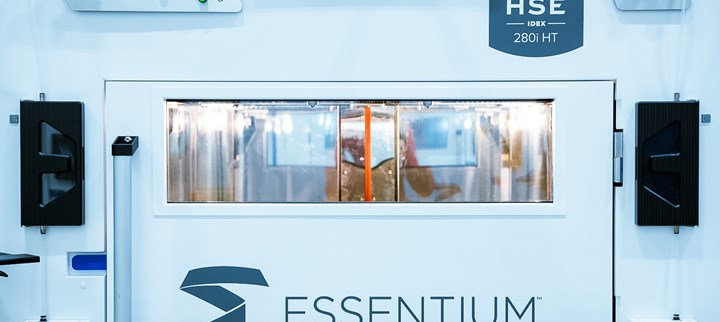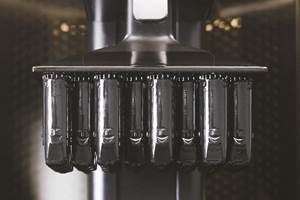How 3D Printing Answers Supply Chain Disruptions
Essentium CEO: Production-speed additive manufacturing is “a time machine and an insurance policy.” It addresses lead time demands while providing buffer against volatility. Look for 3D printing to support injection molding in this way.

Additive manufacturing for production is not an either/or choice. Parts that might usually be made through molding can be made through 3D printing whenever lead time is tight or the usual source of supply is disrupted. Images courtesy of Essentium.
Essentium is an example of an additive manufacturing (AM) technology provider we have watched — the company’s systems are all about scale production, the ultimate promise of AM. However, the core process in its case is fused filament fabrication (FFF), nearly the oldest and best-established method for 3D printing. Where other polymer AM systems depart from FFF for an altogether different 3D printing process, Essentium’s machines are all about accelerating FFF. The systems are essentially additive machine tools, using linear motors in X and Y and extruders with precise control over flow rate and temperature to achieve dimensional repeatability at high rates of building parts through material deposition.
The newest development: The company now makes its system available in an independent dual-extrusion system model in which two different extruders are driven by separate X-Y axis systems.

Essentium’s process is FFF, but at high speed and under precise control.
I spoke with CEO Blake Teipel about the value of separately moving extruders and, more broadly, the state of production-scale 3D printing, particularly what it now has to say after a year in which supply chain disruptions (whether owing to the pandemic, bottlenecks at ports or a ship blocking the Suez Canal) have left manufacturers and their customers questioning their supply chain strategies.
The dual extruders first: Two heads are better than one, and for various potential reasons. “This is the first machine with a truly independent second extruder, and adding this offers a variety of value props,” Teipel says.
One is the use of multiple materials, as in the case of one extruder delivering the part material while the other applies support material. Or, another, different scenario is “copy mode” — the chance to produce two of the same part or two similar parts (such as left and right versions) at the same time. Finally: the chance for the extruders to collaborate on the same build, with a coarse nozzle delivering bulk material and a fine nozzle adding precise details. Essentium is developing software to aid this cooperative use of the two extruders.

A new version of the HSE 280i HT 3D Printer features two extruders moving independently on two different linear motor X-Y axis systems.
All of these possibilities are available to the dual-extruder machine user. And Teipel says this kind of flexibility is the answer to the current supply chain conundrum. That is, flexibility enabled by production-speed 3D printing offers a buffer that can cushion against the likelihood that we may have entered an area in which supply chains are inherently more volatile.
A production-speed AM system is “a time machine and an insurance policy,” he says. The “time machine” part of this is usually the reason to invest in it. Essentium’s system is cost-competitive against injection molding for production quantities in the thousands or tens of thousands, and allows production to begin more quickly and change more easily relative to molding because there is no need to first design and build a mold. The system therefore offers a way to produce low quantities effectively and/or start producing during the months while the mold tooling is in work.
Meanwhile, the insurance policy. This is a secondary benefit of the system, and a close second in value: the chance to quickly pivot into 3D printing when the expected source of supply is disrupted or delayed.
“We saw this ourselves during covid, making face masks,” he says. “We never expected we would be mass-producing PPE, but once we turned to this, we were able to commit 12 machines to it, producing 50,000 pieces in 90 days.”
This is the production role he expects AM increasingly to play. Some polymer parts require quantities only in the tens of thousands; these might never be produced in a mold. Other parts are needed in much high quantities. These parts will be molded in normal times, then they will be 3D printed during the unusual times when there is a surge in demand or an emergency that disrupts the normal flow of parts from the supplier.

Part-making capacity via production-speed 3D printing offers a buffer that can cushion against supply chain volatility.
Related Content
What Does Additive Manufacturing Readiness Look Like?
The promise of distributed manufacturing is alluring, but to get there AM first needs to master scale production. GKN Additive’s Michigan facility illustrates what the journey might look like.
Read MoreSolving 3D Printing’s Hidden Problem: Vibration
Ulendo’s vibration compensation software can double the speed of FFF 3D printers while maintaining part quality, all without changing the machine’s hardware.
Read MoreAM 101: Digital Light Synthesis (DLS)
Digital Light Synthesis (DLS) is the name for Carbon's resin-based 3D printing process. How it works and how it differs from stereolithography.
Read MoreAirless Basketball Shows Promise of 3D Printed Lattices: The Cool Parts Show Bonus
Successfully matching the performance of a standard basketball demonstrates the control possible over the mechanical properties of digital materials.
Read MoreRead Next
The New Normal? Resilient Supply Chains with 3D Printing
We were already headed toward expanded adoption of 3D printing, in HP’s view, when the coronavirus hit. The pandemic’s disruption will only get us there faster.
Read MoreDoes Asia's Low-Cost Manufacturing Option Still Make Sense?
As U.S.-based companies try to stay ahead of COVID-19, global supply chains are under renewed scrutiny. Are uncertainties and delays caused by global crises worth the short-term cost savings?
Read MoreFor Stratasys, Acquisition of Origin Part of Strategy Focused on Production and Polymer Materials
Americas president Rich Garrity describes how the two additive manufacturing technology companies came together (COVID-19 helped), along with the value of protecting one culture while allowing another to change.
Read More





















